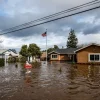Hurricane Oscar has unleashed torrential rain and powerful winds across eastern Cuba, compounding the struggles faced by the island, which recently experienced a nationwide power outage affecting its 10 million residents.
The storm brought winds of up to 75 mph, tearing roofs off houses and causing landslides, further complicating efforts to restore electricity following a massive blackout over the weekend.
Residents in the eastern city of Baracoa reported severe damage, with one noting, “The winds have been very high. The sea is very dangerous, and tiles have been ripped from the roof.”
As Oscar was downgraded to a tropical storm on Monday and shifted north toward the Bahamas, attention turned back to Cuba’s aging electrical grid, which has been increasingly vulnerable due to outdated infrastructure and severe blackouts in recent months.
The situation has led to the loss of stored food and heightened anxiety in a country already grappling with soaring inflation and rising living costs.

In a rare display of urgency, President Miguel Díaz-Canel appeared in military attire, indicative of a national emergency.
The government has implemented drastic measures, including ordering non-essential workers to stay home in hopes of conserving power and keeping the grid operational.
Schools have been closed until Thursday, highlighting the gravity of the crisis.
While electricity has been restored to much of central Cuba, reports indicate that areas in the east and far west remain without power.
In Havana, power began returning in the early hours of Monday, with the government reporting that 56% of the city had regained electricity by lunchtime.
However, residents expressed skepticism about the reliability of the aging power system, leading to frustrations over the government’s communication strategy, which relied heavily on social media platforms.
Díaz-Canel attributed the nation’s challenges to the United States “financial war” against Cuba, warning against external provocations aimed at inciting civil unrest.
The resilience of the Cuban people continues to be tested as they navigate the impacts of natural disasters and systemic infrastructure failures.

